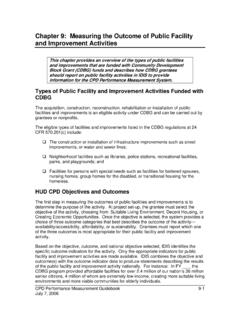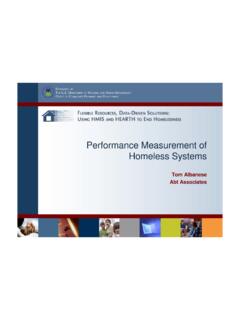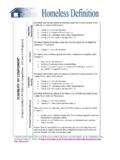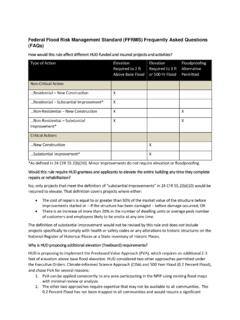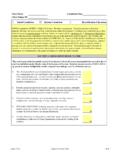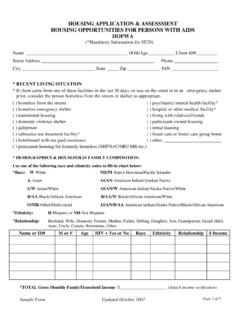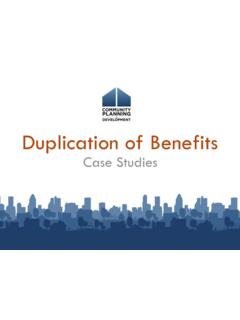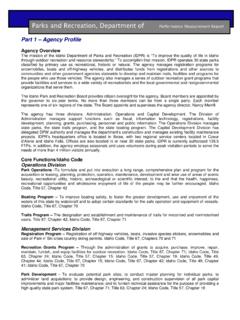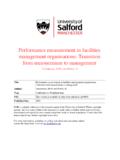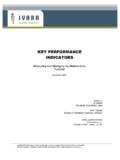Transcription of CHAPTER 18: PERFORMANCE MEASUREMENT, …
1 CHAPTER 18: PERFORMANCE measurement , reporting , recordkeeping and monitoring CHAPTER PURPOSE & CONTENTS This CHAPTER provides states with an overview of three primary aspects of ensuring and documenting compliance with program rules and requirements PERFORMANCE measurement , reporting , recordkeeping , monitoring , and closeout requirements. SECTION TOPIC PERFORMANCE measurement reporting Requirements recordkeeping Requirements monitoring of Program PERFORMANCE Closeout
2 Requirements PERFORMANCE measurement The following is a summary of the topics in this section, applicable statutory and regulatory cites, and other reference materials available from HUD. Key Topics in This Section Objectives Outcomes Indicators Statutory Citations Section 104(b)(4), Section 104(e) Other Reference Materials on This Topic Federal Register Notice, March 7, 2006 PERFORMANCE measurement website: CPD Notice 12-04 Background Overview PERFORMANCE measurement is an organized process for gathering information to determine how well programs and activities are meeting established needs and goals. The PERFORMANCE measurement system was developed to enable HUD and CPD states to use a standardized methodology and system to measure the outcomes of CDBG and the other CPD formula grant programs, HOME, ESG and HOPWA.
3 For states, the system provides a framework for classifying activities in their Consolidated Plans and for reporting specific data elements. The information provided by states will enable HUD to report on the outcomes of the four CPD formula grant programs nationally. Basically CDBG for States (April 2012) 18-1 HUD, Office of Block Grant Assistance CHAPTER 18: PERFORMANCE measurement , reporting , recordkeeping , and monitoring There are three main components to the CPD Outcome PERFORMANCE measurement System: Objectives; Outcomes; and Indicators. Objectives Objectives closely mirror the statutory objectives of each program. The objectives are framed broadly to capture the range of community impacts that occur as a result of program activities.
4 The CPD Outcome PERFORMANCE measurement System offers three possible objectives for each activity. Creating Suitable Living Environments relates to activities that are designed to benefit communities, families, or individuals by addressing issues in their living environment. This objective relates to activities that are intended to address a wide range of issues faced by LMI persons, from physical problems with their environment, such as poor quality infrastructure, to social issues such as crime prevention, literacy, or elderly health services. Providing Decent Housing covers the wide range of housing activities that could be undertaken with CDBG funds. This objective focuses on housing activities where the purpose is to meet individual family or community housing needs.
5 It does not include programs where housing is an element of a larger effort to make community-wide improvements, since such programs would be more appropriately reported under Suitable Living Environments. Creating Economic Opportunities applies to activities related to economic development, commercial revitalization, or job creation. Outcomes The program outcome helps further refine the state and UGLG s objective and is designed to capture the nature of the change or the expected result of the objective that a state seeks to achieve. Outcomes correspond to the question What is the type of change the UGLG is seeking? Or what is the expected result of the activity? The CPD Outcome PERFORMANCE measurement System provides three outcomes: Availability/Accessibility applies to activities that make services, infrastructure, public services, public facilities, housing, or shelter available or accessible to LMI people, including persons with disabilities.
6 In this category, accessibility does not refer only to physical barriers, but also to making the basics of daily living available and accessible to LMI people where they live. Affordability applies to activities that provide affordability in a variety of ways to LMI people. It can include the creation or maintenance of affordable housing, basic infrastructure hook-ups, or services such as transportation or day care. Affordability is an appropriate objective whenever an activity is lowering the cost, improving the quality, or increasing the affordability of a product or service to benefit a low-income household. Example #1: A low interest loan program might make loans available to LMI microenterprise businesses at 1% interest, which is far below the market rate.
7 This Basically CDBG for States (April 2012) 18-2 HUD, Office of Block Grant Assistance CHAPTER 18: PERFORMANCE measurement , reporting , recordkeeping , and monitoring program lowers the cost of the loan, enabling entrepreneurs to start businesses. As a result, the program makes financing more affordable. Example #2: A subsidized day care program that provides services to LMI persons/families at lower cost than unsubsidized day care. Sustainability applies to activities that are aimed at improving communities or neighborhoods, helping to make them livable or viable by providing benefit to persons of LMI or by removing or eliminating slums or blighted areas, through multiple activities or services that sustain communities or neighborhoods.
8 Indicators There are four common indicators that are relevant for most activities. The system requires the state to report on these data elements for nearly all program activities. Amount of money leveraged from other Federal, state, local, and private sources, per activity. Number of persons, households, businesses, units or beds assisted, as appropriate. Income levels of persons or households by: 30 percent, 50 percent or 80 percent of area median income. For CDBG activities that benefit an area, the data reported for that activity will need to show the total number of persons served and the percentage of LMI individuals served. Race, ethnicity, and disability data for activities that currently report these data elements.
9 Under CDBG, race/ethnicity data is required only when the activity is specifically undertaken to directly benefit persons or households, such as job creation activities or housing rehabilitation. Race and ethnicity data is not required for activities under the CDBG LMI area benefit, slum/blight, or urgent need national objectives. In addition to the common indicators that are used for all program activities, there are 18 major activity-specific indicator categories as shown in Exhibit 18-1 at the end of this CHAPTER . PERFORMANCE measurement Wrap Up To ensure compliance, states and their UGLGs have action steps they will need to take when using CPD Outcome PERFORMANCE measurement System: Determine the intent (or goals) of their program activities; Include objectives and outcomes in Consolidated Plans, Action Plans and PERFORMANCE reports; Select objectives and outcomes; Collect applicable data on objectives and outcomes; Record objectives and outcomes in IDIS; Collect indicator data from internal program administration staff and UGLGs; and Report on indicators in IDIS.
10 Basically CDBG for States (April 2012) 18-3 HUD, Office of Block Grant Assistance CHAPTER 18: PERFORMANCE measurement , reporting , recordkeeping , and monitoring Data must be reported at least annually within IDIS, but states are encouraged to report as often as possible. PERFORMANCE measurement indicator data that must be reported in IDIS is collected depending upon the matrix code and national objective chosen. IDIS screens ask all the pertinent information that states need to collect and provide within the system. Complete and accurate data reporting is critical to the success of the CDBG program. Missing and or incorrect information from states results in national data that is flawed. In addition there are new PERFORMANCE measurement reports now available within IDIS.
